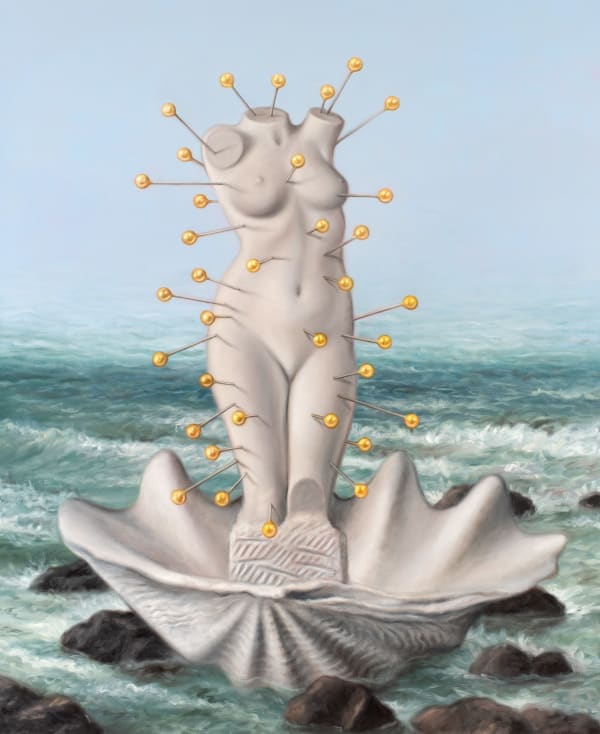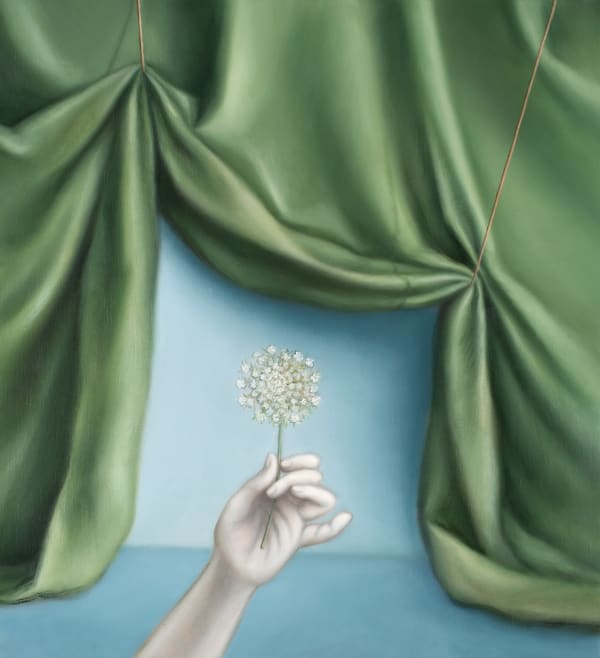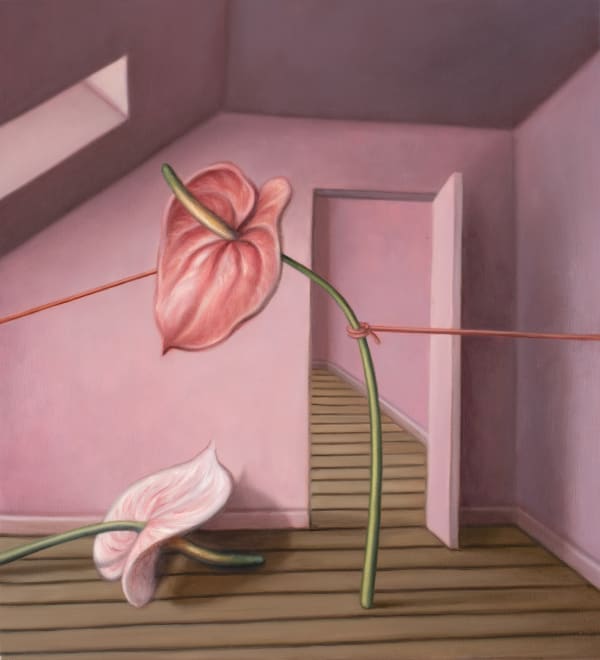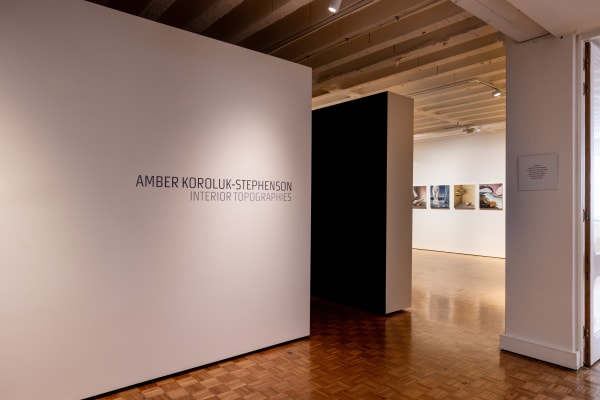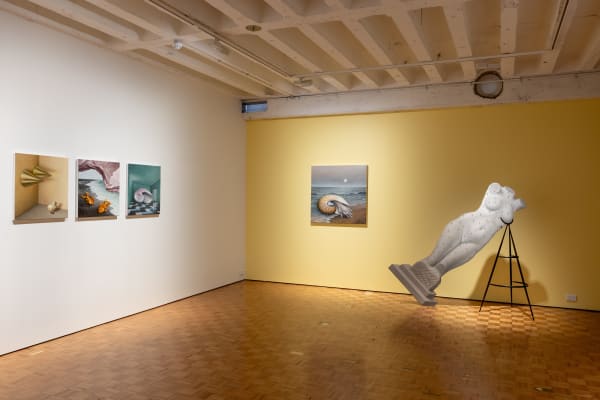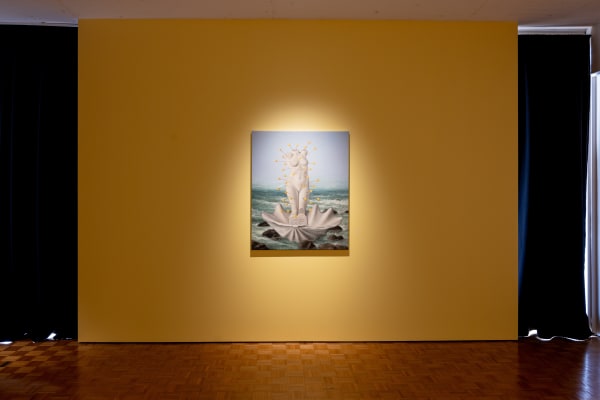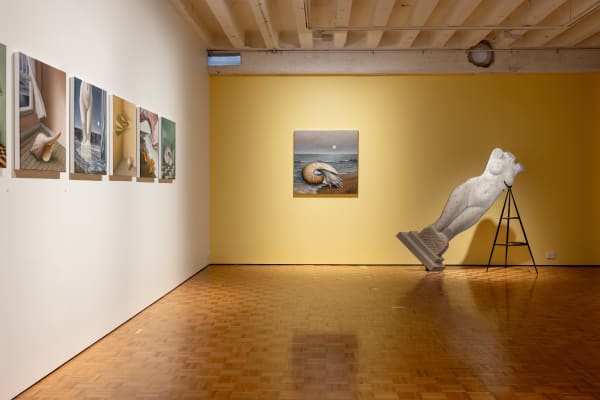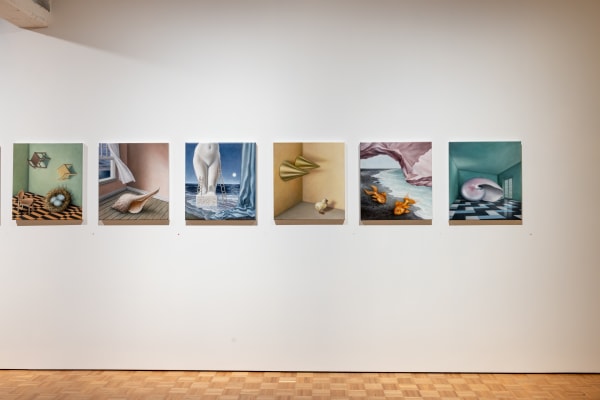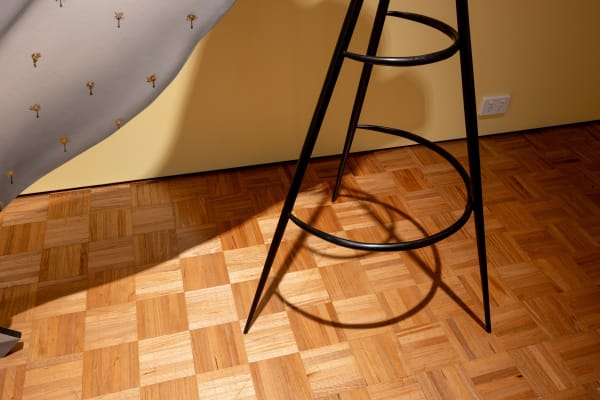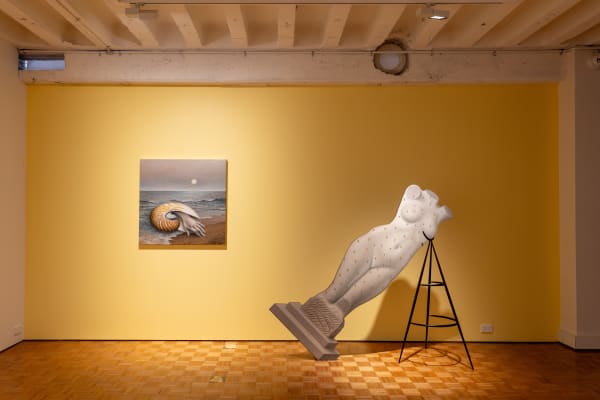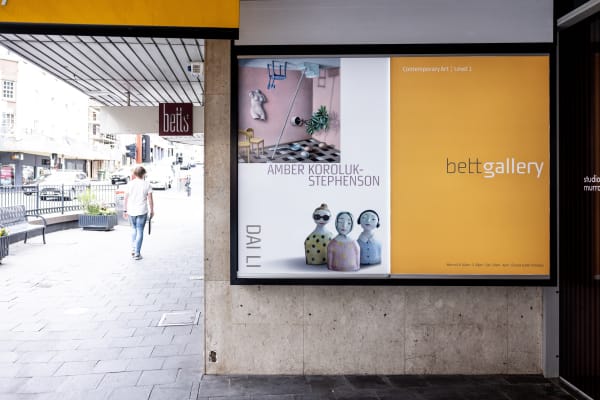AMBER KOROLUK-STEPHENSON: Interior Topographies
Amber Koroluk-Stephenson’s painting practice is well-known for its distinctive blend of real and artificial landscapes and interiors. Dream-like images populated with objects loaded with cultural meaning – rubber gloves, flowers, architectural structures – are all pieced together with meticulous precision.
As the title of Interior Topographies suggests, this body of work takes a more personal turn. Partly based on Koroluk-Stephenson’s feelings of ambivalence towards motherhood, Interior Topographies unfolds as a visual roadmap filled with signs and symbols relating to femininity, domesticity, and body autonomy.
During the development of this body of work, Koroluk-Stephenson spent time thinking about the traps of femininity and how beauty is idealised in art history, mythology, and popular culture. In Gravity of Love, (Madonna and Child) a pair of cones protrude from the wall of a pastel yellow interior. They refer to a bra originally designed by Jean-Paul Gaultier in 1987 and later incorporated into the costuming for Madonna’s ground-breaking 1990 Blonde Ambition tour. Contrasting with the softness of a fluffy yellow chick, the pointy cones flip the maternal expectations of the breast to one of power and protection. As Liam Hess writes in Vogue, “The cone bra grabbed the public’s attention for the way in which it rebelled against the narrow definition of the beautiful female body that, for so many centuries, had been dictated by corsetry’s body-morphing strictures.”[1] Describing the bra as defiantly aggressive, Hess goes on to say, “In place of the soft curves the corset was supposed to shape, the female anatomy became a spiky, phallic weapon, one that Madonna celebrated by exerting her dominance, sexual or otherwise.”
Striving for dominance and autonomy over our own bodies has been the concern of women for centuries. Despite laws instructing women to follow rules and regulations set by (predominantly male) lawmakers, throughout history women have been secretly helping each other remain autonomous, particularly when it comes to birth control. In the twelfth century, German nun Hildegard von Bingen studied herbal medicines that aided in the termination and prevention of pregnancies. Plants like Pennyroyal and Queen Anne’s Lace – depicted by Koroluk-Stephenson in Remedy (Queen Anne’s Lace) – were often used for these purposes. Going even further back in history, the ancient Egyptians advocated the use of douches and suppositories to avoid pregnancy, allowing women choice and autonomy, despite the dire physical risks.
Focusing on the physical form of the Anthurium flower, Koroluk-Stephenson likens its heart shaped petals to female genitalia and its protruding central stem to a phallus. In Captive, the Anthuriums are held tightly by red thread, a visual embodiment of the fear of being bound to the domestic duties associated with motherhood. In Love Lock, a pair of Anthuriums are taped to the walls of a domestic interior, with a ladder propped in one corner and a door leading to another room, the contents of which remain unknown.
Shells, eggs, and nests are also dominant and recurrent visuals. In works like Heartbeat a shell is placed within an interior Koroluk-Stephenson likens to a womb, conjuring a visual reflection on nurture, care, and protection, while Bend is a potent visual expression of the delicate balance required to maintain all aspects of a woman’s life – career, family, and personal aspirations. Here the tightly laced legs of a ballet dancer balance on a row of eggs, physically contorting in weird angles to remain on the unstable and precariously fragile surface. Will the dancer slip? Will the eggs break? Are they fertile or barren? Despite how women feel as individuals, it is fair to argue society holds on tight to a female’s role as mother and caregiver. For many, this is a frustratingly limiting point of view. Not only do women carry the physical expectation of bearing children, once they are born, women carry the immense mental load that comes with caregiving.
Bend recalls a monologue delivered by America Ferrera as she portrays the character of Gloria in Barbie, a 2023 movie directed by Greta Gerwig. Going viral on social media soon after the movie was released, Ferrera’s Gloria expressed her frustrations on how women must contort to meet unrealistic expectations. “You have to be a boss, but you can't be mean. You have to lead, but you can't squash other people's ideas. You're supposed to love being a mother but don't talk about your kids all the damn time. You have to be a career woman but also always be looking out for other people. You have to answer for men's bad behavior, which is insane, but if you point that out, you're accused of complaining. You're supposed to stay pretty for men, but not so pretty that you tempt them too much or that you threaten other women because you're supposed to be a part of the sisterhood.”[2] The contradictions are exorbitant.
Throughout Interior Topographies, there are several direct references to art historical figures. Dawning, after Dora Maar, is a homage to Maar’s 1934 photomontage, Untitled (hand shell), while Man Ray’s 1936 photograph of a rope bound female form, Restored Venus, is recalled in the multiple portrayals of figurative female busts (now unbound) present in many of Koroluk-Stephenson’s images.
In Rebirth of Australian Venus, after Rayner Hoff, Koroluk-Stephenson alludes to the English artist’s 1927 Australian Venus – a marble sculpture of what he believed to be a representation of the “national body.”[3] Hoff’s original sculpture was classically styled, hairless and without limbs. The body he chose was female, possessing a lithe, slender frame with ample sized breasts and good child-bearing hips. In Koroluk-Stephenson’s painting, the body of Venus is rebirthed from a shell and covered in pins, recalling the pointing technique developed by eighteenth century Italian sculptor Antonio Canova to achieve perfect proportions. Proportions that in reality, are far from realistic.
Wrapped in pastel-hued softness, Interior Topographies quietly delivers a visual sucker punch, unravelling gender role expectations from both a historical and personal point of view. Clearing a path across our complicated social landscape, Koroluk-Stephenson sifts through the detritus to reveal a trail of visual breadcrumbs leading to a female identity that fits – despite all the noise from the outside world.
Briony Downes, 2024
[1] Hess, Liam, The Story Behind Madonna’s Iconic Jean-Paul Gaultier Cone Bra, Vogue online, 18.04.2020 https://www.vogue.com/article/madonna-blonde-ambition-jean-paul-gaultier-cone-bra Retrieved 21.01.2024
[2] Gerwig, Greta and Baumbach, Noah (screenplay) Barbie, Warner Bros. 2023
[3] Rayner Hoff artist biography, Art Gallery of New South Wales online, https://www.artgallery.nsw.gov.au/collection/artists/hoff-rayner/ Retrieved 06.02.2024.
Amber Koroluk-Stephenson is a visual artist based in Huon Valley in southern lutruwita/Tasmania. Working across painting, sculpture and collage, she balances the banal with the strange to create slippages within everyday fantasies. Informed by an ongoing fascination with the intersections between natural and built environments, history and popular culture, Amber’s practice examines the illusory nature, value and significance of identity, place and belonging, and ways cultural significance is constructed and exchanged, but also sometimes lost.
Since graduating from the Tasmanian School of Art with a BFA (Honours) in 2010, Amber has held numerous solo and group exhibitions. Recent exhibitions of note include Settings for Uncertainty, Rosny Farm Arts Centre (2023), Relationships and Limitations RANT Arts, Devonport (2023) f i g m e n t, Lady Franklin Gallery (2023) and Always Tomorrow, Moonah Arts Centre. Past solo exhibitions include A Hopeful Mirage, Bett Gallery (2022) 2021 Split Vision, Glover Country, Deddington (2021), Breaking Horizons, Bett Gallery (2020), Middleground, Bett Gallery (2018), Shadows on the Wall, Anna Pappas Gallery (2017), Homeland, Devonport Regional Gallery (2017) and Many-Sided Face, Contemporary Art Tasmania (2016).
Amber was the winner of the 2018 Ravenswood Australian Women’s Art Prize (emerging) and has been selected as a finalist for a number of Australian prizes including The Churchie National Emerging Artist Prize, Tidal National Art Award, Redlands Art Award, Albany Art Prize, Portia Geach Memorial Award and the Glover Prize. Amber’s work is held in both public and public collections nationally and internationally including the Tasmanian State Collection, Artbank and the Queen Victoria Museum and Art Gallery.
-
 Amber Koroluk-StephensonRebirth of Australian Venus, after Rayner Hoff, 2023-2024oil on linen112 x 91.5 cmReserved
Amber Koroluk-StephensonRebirth of Australian Venus, after Rayner Hoff, 2023-2024oil on linen112 x 91.5 cmReserved -
 Amber Koroluk-StephensonA sum of parts (a dream of Venus, after Man Ray), 2023oil on linen91.5 x 91.5 cmAU$ 6,200.00
Amber Koroluk-StephensonA sum of parts (a dream of Venus, after Man Ray), 2023oil on linen91.5 x 91.5 cmAU$ 6,200.00 -
 Amber Koroluk-StephensonLove Lock, 2023oil on linen91.5 x 91.5 cmAU$ 6,200.00
Amber Koroluk-StephensonLove Lock, 2023oil on linen91.5 x 91.5 cmAU$ 6,200.00 -
 Amber Koroluk-StephensonDawning, after Dora Maar, 2023-2024oil on linen91.5 x 91.5 cmSold
Amber Koroluk-StephensonDawning, after Dora Maar, 2023-2024oil on linen91.5 x 91.5 cmSold -
 Amber Koroluk-StephensonGravity of Love (Madonna and Child), 2023oil on linen60 x 55 cmSold
Amber Koroluk-StephensonGravity of Love (Madonna and Child), 2023oil on linen60 x 55 cmSold -
 Amber Koroluk-StephensonBend, 2023-2024oil on linen60 x 55 cmAU$ 3,600.00
Amber Koroluk-StephensonBend, 2023-2024oil on linen60 x 55 cmAU$ 3,600.00 -
 Amber Koroluk-StephensonLimits of Love, 2023oil on linen60 x 55 cmAU$ 3,600.00
Amber Koroluk-StephensonLimits of Love, 2023oil on linen60 x 55 cmAU$ 3,600.00 -
 Amber Koroluk-StephensonSlow Dance, 2023-2024oil on linen60 x 55 cmSold
Amber Koroluk-StephensonSlow Dance, 2023-2024oil on linen60 x 55 cmSold -
 Amber Koroluk-StephensonHeartbeat, 2024oil on linen60 x 55 cmSold
Amber Koroluk-StephensonHeartbeat, 2024oil on linen60 x 55 cmSold -
 Amber Koroluk-StephensonHerbal Remedy (Queen Anne's Lace), 2023 - 2024oil on linen60 x 55 cmAU$ 3,600.00
Amber Koroluk-StephensonHerbal Remedy (Queen Anne's Lace), 2023 - 2024oil on linen60 x 55 cmAU$ 3,600.00 -
 Amber Koroluk-StephensonGood Listener, 2023oil on linen60 x 55 cmSold
Amber Koroluk-StephensonGood Listener, 2023oil on linen60 x 55 cmSold -
 Amber Koroluk-StephensonDeath of a Porn Star, after Goldie Saunders, 2023-2024oil on linen60 x 55 cmAU$ 3,600.00
Amber Koroluk-StephensonDeath of a Porn Star, after Goldie Saunders, 2023-2024oil on linen60 x 55 cmAU$ 3,600.00 -
 Amber Koroluk-StephensonEscape Artist, portrait of an Australian Painted Lady, 2023 - 2024oil on linen60 x 55 cmSold
Amber Koroluk-StephensonEscape Artist, portrait of an Australian Painted Lady, 2023 - 2024oil on linen60 x 55 cmSold -
 Amber Koroluk-StephensonCaptive, 2024oil on linen60 x 55 cmAU$ 3,600.00
Amber Koroluk-StephensonCaptive, 2024oil on linen60 x 55 cmAU$ 3,600.00 -
 Amber Koroluk-StephensonBeauty Belies (Australian Venus, after Rayner Hoff), 2023-2024oil, gold leaf and nails on marine ply, stained Tasmanian oak stand made by Benjamin Grieve-Johnson of "Other Furniture"variablePOA
Amber Koroluk-StephensonBeauty Belies (Australian Venus, after Rayner Hoff), 2023-2024oil, gold leaf and nails on marine ply, stained Tasmanian oak stand made by Benjamin Grieve-Johnson of "Other Furniture"variablePOA

